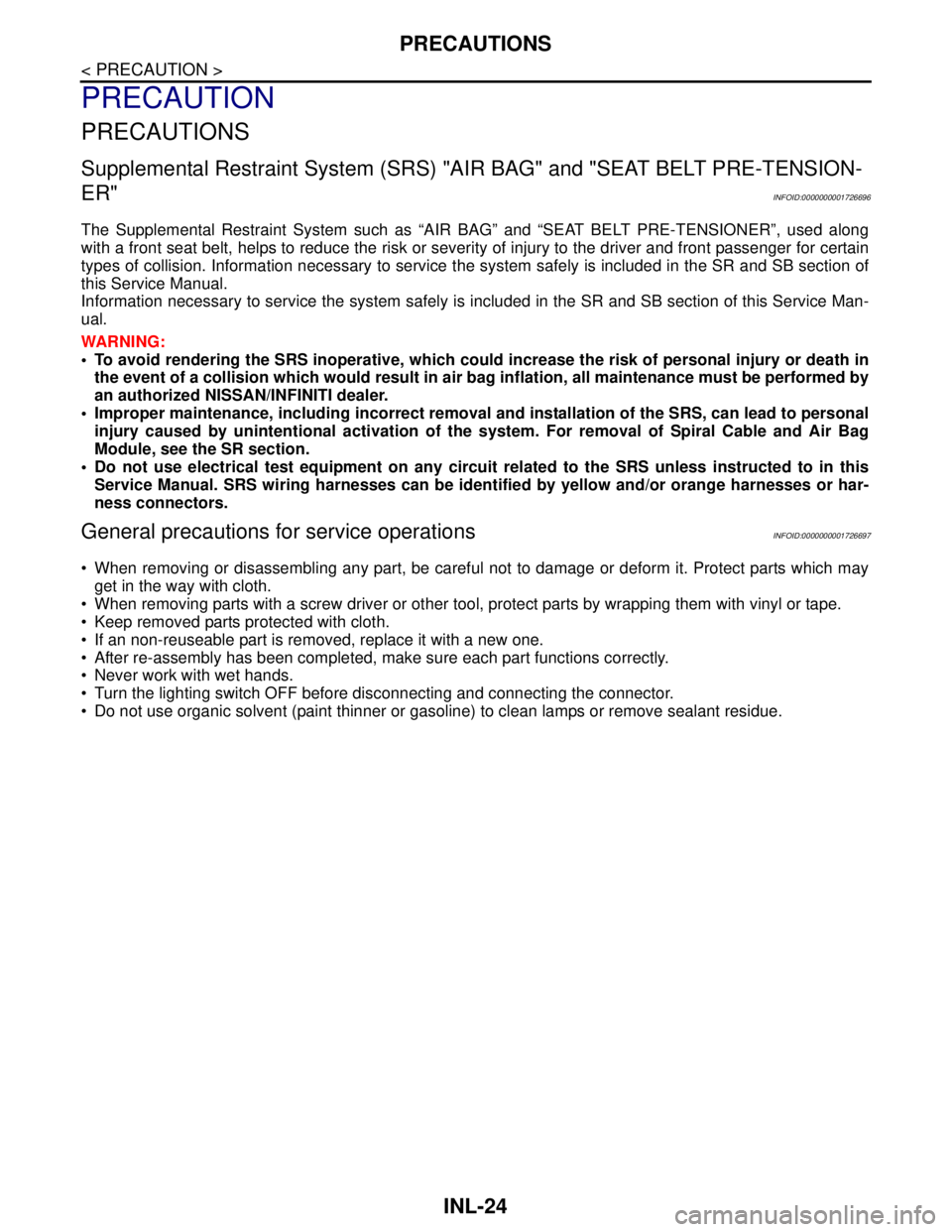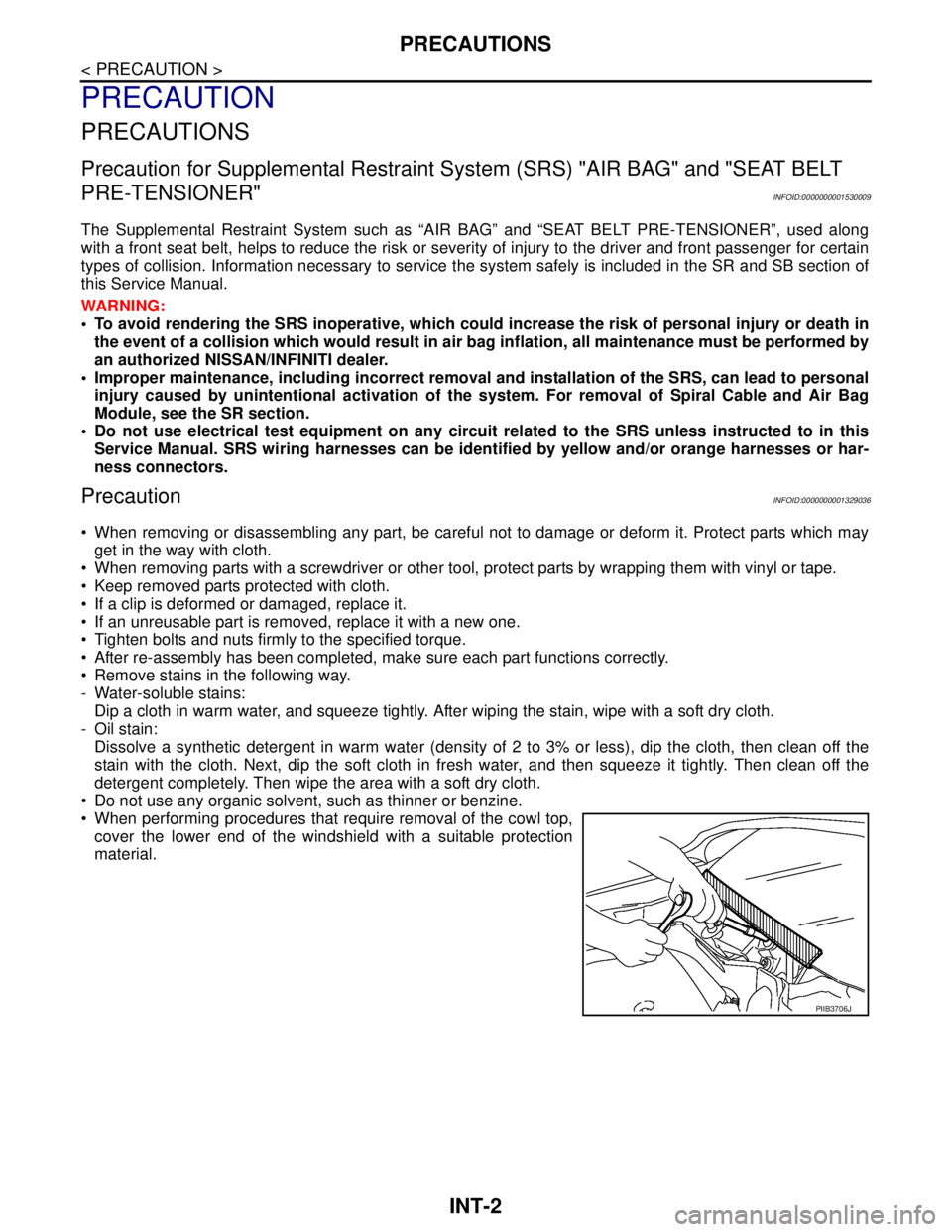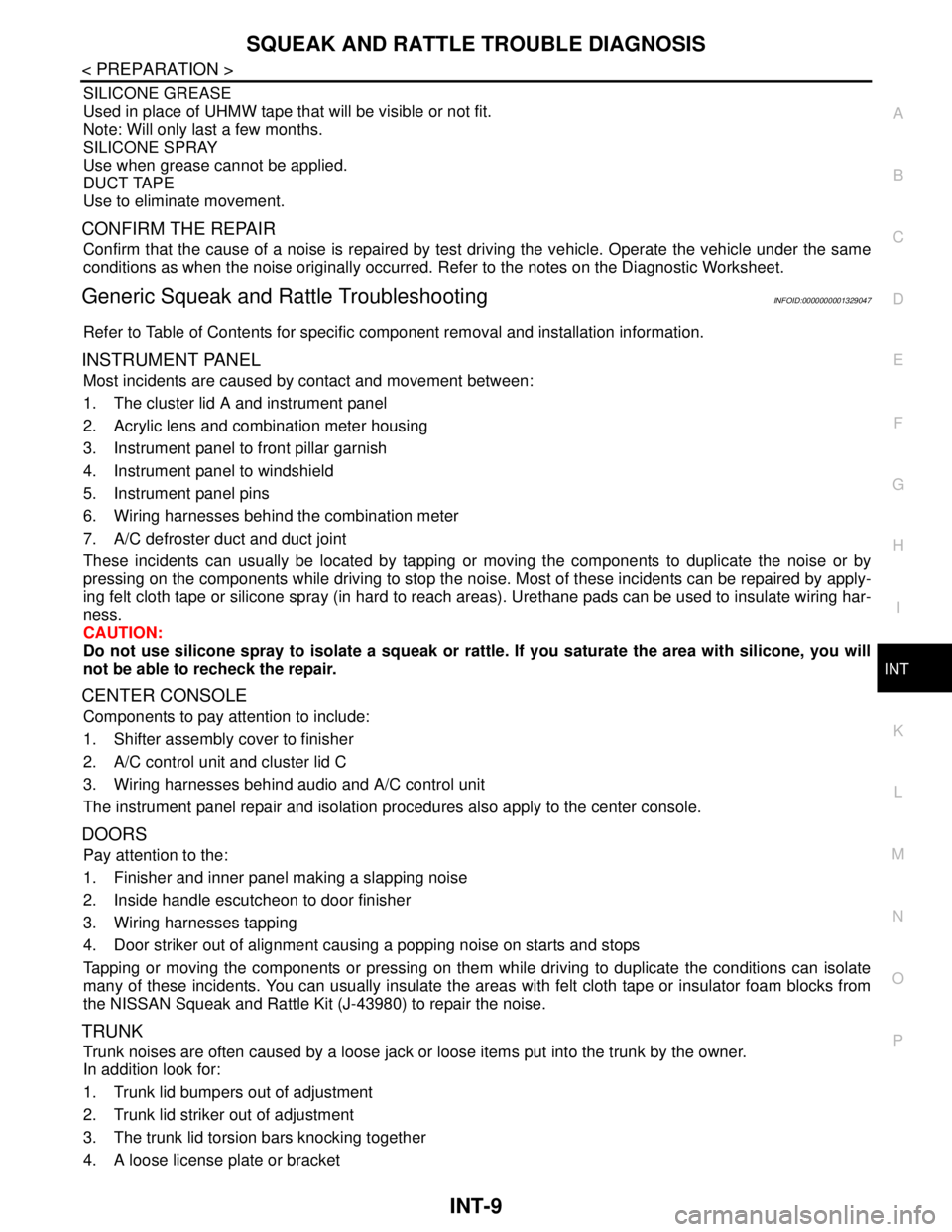2007 NISSAN TIIDA front
[x] Cancel search: frontPage 3658 of 5883

INTERIOR ROOM LAMP CONTROL SYSTEM
INL-7
< FUNCTION DIAGNOSIS >
C
D
E
F
G
H
I
J
K
MA
B
INL
N
O
P
Back door lock assembly (hatchback)
Provides back door OPEN/CLOSED status to the BCM.
Back door opener switch (hatchback)
Trunk lid opener switch (sedan) Provides trunk lid OPEN/CLOSED status to the BCM.
Main power window and door lock/unlock switch [front door lock
assembly LH (key cylinder switch)]. Provides door lock/unlock position switch LH status to the BCM.
Page 3662 of 5883

DIAGNOSIS SYSTEM (BCM)
INL-11
< FUNCTION DIAGNOSIS >
C
D
E
F
G
H
I
J
K
MA
B
INL
N
O
P
*: Initial setting
DATA MONITOR
ROOM LAMP ON TIME SETMODE 1 0.5 sec.
Sets the interior room lamp gradual brightening time. MODE 2* 1 sec.
MODE 3 2 sec.
MODE 4 3 sec.
MODE 5 4 sec.
MODE 6 5 sec.
MODE 7 0 sec.
ROOM LAMP OFF TIME SETMODE 1 0.5 sec.
Sets the interior room lamp gradual dimming time. MODE 2* 1 sec.
MODE 3 2 sec.
MODE 4 3 sec.
MODE 5 4 sec.
MODE 6 5 sec.
MODE 7 0 sec.
R LAMP TIMER LOGIC SETMODE 1* Interior room lamp timer activates with synchronizing all doors.
MODE 2Interior room lamp timer activates with synchronizing the driver door
only. Service item Setting item Setting
Monitor item
[Unit]Description
IGN ON SW
[ON/OFF]Ignition switch (ON) status judges from IGN signal (ignition power supply)
ACC SW
[ON/OFF]Ignition switch (ACC) status judges from ACC signal (ACC power supply)
KEY ON SW
[ON/OFF]The switch status input from key switch
PUSH SW
[ON/OFF]Push switch status received from Intelligent Key unit by CAN communication
DOOR SW-DR
[ON/OFF]The switch status input from front door switch (driver side)
DOOR SW-AS
[ON/OFF]The switch status input from front door switch (passenger side)
DOOR SW-RR
[ON/OFF]The switch status input from rear door switch RH
DOOR SW- RL
[ON/OFF]The switch status input from rear door switch LH
BACK DOOR SW
[ON/OFF]The switch status input from back door switch
CDL LOCK SW
[ON/OFF]Lock switch status input from door lock and unlock switch
CDL UNLOCK SW
[ON/OFF]Unlock switch status input from door lock and unlock switch
I-KEY LOCK
[ON/OFF]Lock signal status received from Intelligent Key unit by CAN communication
I-KEY UNLOCK
[ON/OFF]Unlock signal status received from Intelligent Key unit by CAN communication
Page 3663 of 5883

INL-12
< FUNCTION DIAGNOSIS >
DIAGNOSIS SYSTEM (BCM)
ACTIVE TEST
BATTERY SAVER
BATTERY SAVER : CONSULT-III Function (BCM - BATTERY SAVER)INFOID:0000000001728868
WORK SUPPORT
*: Initial setting
DATA MONITOR
KEYLESS LOCK
[ON/OFF]Lock signal status received from remote keyless entry receiver (integrated in the
BCM)
KEYLESS UNLOCK
[ON/OFF]Unlock signal status received from remote keyless entry receiver (integrated in the
BCM) Monitor item
[Unit]Description
Test item Operation Description
INT LAMPONOutputs the interior room lamp control signal to turn the interior room lamps ON.
[Map lamp, personal lamp, room lamp, luggage room lamp (when applicable lamps
switch is in DOOR position.)]
OFF Stops the interior room lamp control signal to turn the interior room lamps.
Service item Setting item Setting
ROOM LAMP TIMER SETMODE 1* 30 min.
Sets the interior room lamp battery saver timer operating
time.
MODE 2 60 min.
Monitor item
[Unit]Description
IGN ON SW
[ON/OFF]Ignition switch (ON) status judges from IGN signal (ignition power supply)
ACC SW
[ON/OFF]Ignition switch (ACC) status judges from ACC signal (ACC power supply)
KEY ON SW
[ON/OFF]The switch status input from key switch
PUSH SW
[ON/OFF]Push switch status received from Intelligent Key unit by CAN communication
DOOR SW-DR
[ON/OFF]The switch status input from front door switch (driver side)
DOOR SW-AS
[ON/OFF]The switch status input from front door switch (passenger side)
DOOR SW-RR
[ON/OFF]The switch status input from rear door switch RH
DOOR SW- RL
[ON/OFF]The switch status input from rear door switch LH
BACK DOOR SW
[ON/OFF]The switch status input from back door switch
CDL LOCK SW
[ON/OFF]Lock switch status input from door lock and unlock switch
CDL UNLOCK SW
[ON/OFF]Unlock switch status input from door lock and unlock switch
I-KEY LOCK
[ON/OFF]Lock signal status received from Intelligent Key unit by CAN communication
Page 3675 of 5883

INL-24
< PRECAUTION >
PRECAUTIONS
PRECAUTION
PRECAUTIONS
Supplemental Restraint System (SRS) "AIR BAG" and "SEAT BELT PRE-TENSION-
ER"
INFOID:0000000001726696
The Supplemental Restraint System such as “AIR BAG” and “SEAT BELT PRE-TENSIONER”, used along
with a front seat belt, helps to reduce the risk or severity of injury to the driver and front passenger for certain
types of collision. Information necessary to service the system safely is included in the SR and SB section of
this Service Manual.
Information necessary to service the system safely is included in the SR and SB section of this Service Man-
ual.
WARNING:
• To avoid rendering the SRS inoperative, which could increase the risk of personal injury or death in
the event of a collision which would result in air bag inflation, all maintenance must be performed by
an authorized NISSAN/INFINITI dealer.
Improper maintenance, including incorrect removal and installation of the SRS, can lead to personal
injury caused by unintentional activation of the system. For removal of Spiral Cable and Air Bag
Module, see the SR section.
Do not use electrical test equipment on any circuit related to the SRS unless instructed to in this
Service Manual. SRS wiring harnesses can be identified by yellow and/or orange harnesses or har-
ness connectors.
General precautions for service operationsINFOID:0000000001726697
When removing or disassembling any part, be careful not to damage or deform it. Protect parts which may
get in the way with cloth.
When removing parts with a screw driver or other tool, protect parts by wrapping them with vinyl or tape.
Keep removed parts protected with cloth.
If an non-reuseable part is removed, replace it with a new one.
After re-assembly has been completed, make sure each part functions correctly.
Never work with wet hands.
Turn the lighting switch OFF before disconnecting and connecting the connector.
Do not use organic solvent (paint thinner or gasoline) to clean lamps or remove sealant residue.
Page 3676 of 5883

INTERIOR ROOM LAMP
INL-25
< ON-VEHICLE REPAIR >
C
D
E
F
G
H
I
J
K
MA
B
INL
N
O
P
ON-VEHICLE REPAIR
INTERIOR ROOM LAMP
Removal and InstallationINFOID:0000000001726698
MAP LAMP
Removal
1. Disconnect the negative battery cable.
2. Insert a suitable tool and release the pawl, then remove map lamp from overhead console assembly.
3. Disconnect the connectors, then remove map lamp.
Installation
Installation is in the reverse order of removal.
Bulb Replacement
1. Disconnect the negative battery cable.
2. Using a suitable tool, release the tabs and remove map lamp
lens (1) RH/LH.
3. Pull bulb end from Y-shaped connector first to remove.
NOTE:
Install the map lamp lens (1) so the round lens is positioned to
the front of the vehicle as shown.
VANITY MIRROR LAMP (if equipped)
Removal
The vanity mirror lamp is replaced as part of the sunvisor assembly. Refer to INT-29, "Component".
Installation
Installation is in the reverse order of removal.
Bulb Replacement
1. Disconnect the negative battery cable.
2. Using a suitable tool (A), release the tabs and remove the vanity
mirror lamp lens (1).
3. Pull bulb (2) straight out to remove.
GLOVE BOX LAMP (if equipped)
Removal
1. Disconnect the negative battery cable.
2. Remove the lower instrument glove box assembly. Refer to IP-11, "
Removal and Installation". Map lamp bulb : 12V - 8W
LKIA0773E
Vanity mirror lamp bulb : 12V - 2W
AWLIA0140ZZ
Page 3681 of 5883

INT-2
< PRECAUTION >
PRECAUTIONS
PRECAUTION
PRECAUTIONS
Precaution for Supplemental Restraint System (SRS) "AIR BAG" and "SEAT BELT
PRE-TENSIONER"
INFOID:0000000001530009
The Supplemental Restraint System such as “AIR BAG” and “SEAT BELT PRE-TENSIONER”, used along
with a front seat belt, helps to reduce the risk or severity of injury to the driver and front passenger for certain
types of collision. Information necessary to service the system safely is included in the SR and SB section of
this Service Manual.
WARNING:
• To avoid rendering the SRS inoperative, which could increase the risk of personal injury or death in
the event of a collision which would result in air bag inflation, all maintenance must be performed by
an authorized NISSAN/INFINITI dealer.
Improper maintenance, including incorrect removal and installation of the SRS, can lead to personal
injury caused by unintentional activation of the system. For removal of Spiral Cable and Air Bag
Module, see the SR section.
Do not use electrical test equipment on any circuit related to the SRS unless instructed to in this
Service Manual. SRS wiring harnesses can be identified by yellow and/or orange harnesses or har-
ness connectors.
PrecautionINFOID:0000000001329036
When removing or disassembling any part, be careful not to damage or deform it. Protect parts which may
get in the way with cloth.
When removing parts with a screwdriver or other tool, protect parts by wrapping them with vinyl or tape.
Keep removed parts protected with cloth.
If a clip is deformed or damaged, replace it.
If an unreusable part is removed, replace it with a new one.
Tighten bolts and nuts firmly to the specified torque.
After re-assembly has been completed, make sure each part functions correctly.
Remove stains in the following way.
- Water-soluble stains:
Dip a cloth in warm water, and squeeze tightly. After wiping the stain, wipe with a soft dry cloth.
- Oil stain:
Dissolve a synthetic detergent in warm water (density of 2 to 3% or less), dip the cloth, then clean off the
stain with the cloth. Next, dip the soft cloth in fresh water, and then squeeze it tightly. Then clean off the
detergent completely. Then wipe the area with a soft dry cloth.
Do not use any organic solvent, such as thinner or benzine.
When performing procedures that require removal of the cowl top,
cover the lower end of the windshield with a suitable protection
material.
PIIB3706J
Page 3688 of 5883

SQUEAK AND RATTLE TROUBLE DIAGNOSIS
INT-9
< PREPARATION >
C
D
E
F
G
H
I
K
L
MA
B
INT
N
O
P
SILICONE GREASE
Used in place of UHMW tape that will be visible or not fit.
Note: Will only last a few months.
SILICONE SPRAY
Use when grease cannot be applied.
DUCT TAPE
Use to eliminate movement.
CONFIRM THE REPAIR
Confirm that the cause of a noise is repaired by test driving the vehicle. Operate the vehicle under the same
conditions as when the noise originally occurred. Refer to the notes on the Diagnostic Worksheet.
Generic Squeak and Rattle TroubleshootingINFOID:0000000001329047
Refer to Table of Contents for specific component removal and installation information.
INSTRUMENT PANEL
Most incidents are caused by contact and movement between:
1. The cluster lid A and instrument panel
2. Acrylic lens and combination meter housing
3. Instrument panel to front pillar garnish
4. Instrument panel to windshield
5. Instrument panel pins
6. Wiring harnesses behind the combination meter
7. A/C defroster duct and duct joint
These incidents can usually be located by tapping or moving the components to duplicate the noise or by
pressing on the components while driving to stop the noise. Most of these incidents can be repaired by apply-
ing felt cloth tape or silicone spray (in hard to reach areas). Urethane pads can be used to insulate wiring har-
ness.
CAUTION:
Do not use silicone spray to isolate a squeak or rattle. If you saturate the area with silicone, you will
not be able to recheck the repair.
CENTER CONSOLE
Components to pay attention to include:
1. Shifter assembly cover to finisher
2. A/C control unit and cluster lid C
3. Wiring harnesses behind audio and A/C control unit
The instrument panel repair and isolation procedures also apply to the center console.
DOORS
Pay attention to the:
1. Finisher and inner panel making a slapping noise
2. Inside handle escutcheon to door finisher
3. Wiring harnesses tapping
4. Door striker out of alignment causing a popping noise on starts and stops
Tapping or moving the components or pressing on them while driving to duplicate the conditions can isolate
many of these incidents. You can usually insulate the areas with felt cloth tape or insulator foam blocks from
the NISSAN Squeak and Rattle Kit (J-43980) to repair the noise.
TRUNK
Trunk noises are often caused by a loose jack or loose items put into the trunk by the owner.
In addition look for:
1. Trunk lid bumpers out of adjustment
2. Trunk lid striker out of adjustment
3. The trunk lid torsion bars knocking together
4. A loose license plate or bracket
Page 3689 of 5883

INT-10
< PREPARATION >
SQUEAK AND RATTLE TROUBLE DIAGNOSIS
Most of these incidents can be repaired by adjusting, securing or insulating the item(s) or component(s) caus-
ing the noise.
SUNROOF/HEADLINING
Noises in the sunroof/headlining area can often be traced to one of the following:
1. Sunroof lid, rail, linkage or seals making a rattle or light knocking noise
2. Sun visor shaft shaking in the holder
3. Front or rear windshield touching headliner and squeaking
Again, pressing on the components to stop the noise while duplicating the conditions can isolate most of these
incidents. Repairs usually consist of insulating with felt cloth tape.
OVERHEAD CONSOLE (FRONT AND REAR)
Overhead console noises are often caused by the console panel clips not being engaged correctly. Most of
these incidents are repaired by pushing up on the console at the clip locations until the clips engage.
In addition look for:
1. Loose harness or harness connectors.
2. Front console map/reading lamp lens loose.
3. Loose screws at console attachment points.
SEATS
When isolating seat noise it's important to note the position the seat is in and the load placed on the seat when
the noise is present. These conditions should be duplicated when verifying and isolating the cause of the
noise.
Cause of seat noise include:
1. Headrest rods and holder
2. A squeak between the seat pad cushion and frame
3. The rear seatback lock and bracket
These noises can be isolated by moving or pressing on the suspected components while duplicating the con-
ditions under which the noise occurs. Most of these incidents can be repaired by repositioning the component
or applying urethane tape to the contact area.
UNDERHOOD
Some interior noise may be caused by components under the hood or on the engine wall. The noise is then
transmitted into the passenger compartment.
Causes of transmitted underhood noise include:
1. Any component installed on the engine wall
2. Components that pass through the engine wall
3. Engine wall mounts and connectors
4. Loose radiator pins
5. Hood bumpers out of adjustment
6. Hood striker out of adjustment
These noises can be difficult to isolate since they cannot be reached from the interior of the vehicle. The best
method is to secure, move or insulate one component at a time and test drive the vehicle. Also, engine RPM
or load can be changed to isolate the noise. Repairs can usually be made by moving, adjusting, securing, or
insulating the component causing the noise.